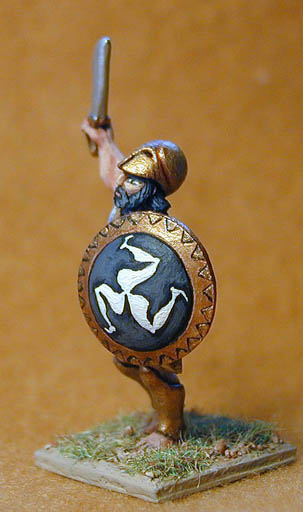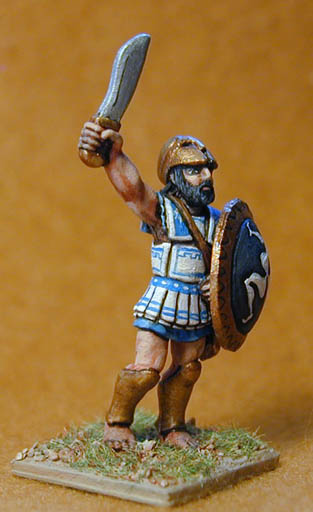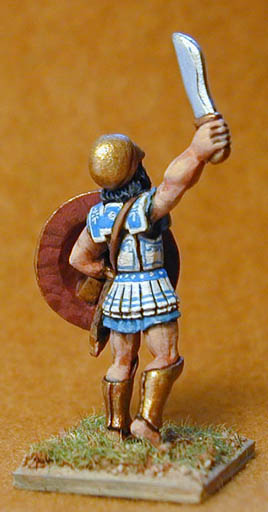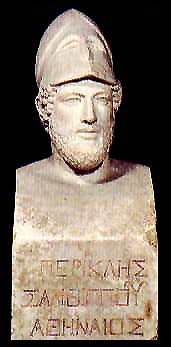![]()
The Statesman
Jeff Jonas
"In short, I say that as a city we are the school of Hellas, while I doubt if the world can produce a man who, where he has only himself to depend upon, is equal to so many emergencies, and graced by so happy a versatility, as the Athenian"
Pericles in 28mm

Pericles here is a 28mm model produced by Xyston miniatures. This company has been producing high quality 15mm figures but recently released a series of character figures. These figures are very finely sculpted and cast. In the case of Pericles the model is especially well done. The only complaint I would levy is the large size of the sword. This heavy handed approach to the weapons is carried throughout these figures, but in this case I felt that major surgery was not warranted, but still, I will note the sword is way too big!




I decided that Pericles would wear a blue chiton (tunic). There is no real historical reason for this other than I felt that blue would look good here. The model really shows off the typical hoplite panoply of mid 5th century Greece. At this time the Greeks had stopped wearing the heavy bronze bell cuirass and turned to lighter (and cheaper materials). In this case the Xyston figure has an excellently sculpted and delicate Tube and Yoke armor. Also called linothorax, this cuirass was made out of layers of linen glued together. The resulting armor protection is stronger than leather but much lighter than metal, modern re-constructors have made these sets of armor and state that they are stronger than laminated fiberglass. The material could be highly decorated as is depicted in period vase art.
Pericles carries the typical equipment of an Athenian hoplite (a term meaning "an equipped man"). Besides the cuirass he carries an aspis (shield) that is made of wood and covered with a thin sheet of bronze hammered into shape. This shield was the hoplite's most important piece of equipment, and all hoplites carried the large 32-36 inch shield even if they wore no other armor. Pericles also wears greaves which were bronze sheets pounded into shape to fit each wearers legs. The springiness of the thin bronze allows the wearer to pull them onto his calf.
He also wears a Corinthian helmet
resting on his head. Some ancient authors have noted that Pericles was
blessed with perfect symmetry except for an elongated head. One reason
why busts and statues of Pericles are shown with the helmet is that some
assume that he covered his odd shaped dome, hiding his one off-putting
physical attribute. One should note that in ancient Greece these busts
were painted, just as our miniatures are.... the blank marble look is a
taste inherited from Michelangelo, not Pheidias.
(See how the Parthenon really might have looked through the genius of
Sir Lawrence Alma-Tadema's brilliant work PHEIDIAS
AND
THE FRIEZE)
Pericles carries a sword called a kopis, instead of the long doru (spear) that could reach nine feet in length. As stated above this item is enlarged but does follow the shape of this Greek cutting sword. (Also known as a falcata in the west).

Pericles carries his large shield on his left arm which covers almost the whole of his exposed body not covered by bronze. Xyston has provides a nice large shield (many miniature sculptors skimp here), with some very nice and delicate scalloping on the edge. These shields were polished and often decorated with familial, religious, or national designs. In the case of Pericles I have opted for the triskeles (three legged) design that is often attributed to the Athenian Alcmaeonidae clan. The shield design link above goes to an article by Nick Sekunda where he describes some Greek shield designs. In any event the triskeles is an elegant device and is a lot more complex to paint than one might assume.
The final effect of this Xyston figure is fantastic for 28mm scale. A clean sculpt, and nice pose (not too animated), and accurate equipment make this a figure that anyone can add to their hoplite army. It was a joy to paint, and I hope this figure will join my Athenian hoplites of Foundry and Vendel origin soon.

Pericles came to power in Athens based mostly on his wits and his oratory. He was a Strategos and lead Athenian armies to victories, notably at Sicyon, and he fought alongside his political enemy Cimon at Tanagra. At one time Athenian armies held large parts of Boeotian territory. Eventually the Athenians could not hold onto their land gains in Greece and Pericles made peace and redirected his efforts to naval domination of the Aegean. His policies turned the Delian League formed against Persia into an Athenian "Thalassocracy" (Sea Empire). The Athenians built their long walls from Athens to the port of Piraeus and decided to rest their major strategy in war on Naval power. When the 2nd Peloponnesian War broke out between the Athenian Empire and a fearful Sparta, Corinth, and Thebes, Pericles trusted in a strategy of attrition against the enemies on land, and naval domination on sea.
Neither the Spartans or the Athenians understood the war that they started in 431 BC, or that it would drag on for 27 years and bleed Greece dry, and rage over lands as far away as Sicily to the shores of the Bosphorus. The Spartans invaded Attica and ravaged the farms as the Athenians from the countryside huddled inside the long walls to Piraeus. Athenian fleets raided the coast of Sparta with impunity, but could not goad the Messenians or allies to rebel from Sparta. The Spartan army was unstoppable but the Athenian cavalry harassed the raiders as they spread out to ineffectively destroy Athenian farmlands. The Athenian fleet prevented any assault on Athens, and kept the food flowing in. In effect the war was a stalemate.
After a number of Spartan invasions fizzled out, Athens delaying strategy was starting to hurt Sparta and their allies. But at Athens the huddled masses of refugees crammed into the city resulted in a devastating plague. which killed thousands. Pericles lost two sons and a sister to the plague, then he himself succumbed himself to the disease. His greatest moments are remembered by Thucydides in his great funeral oration, where his commentary on war and sacrifice is still one of the great discourses on the subject of how people bury their dead in war and resonates today as effectively as 2400 years ago. Sadly there are few great orators today of the likes of Pericles.
After Pericles' death the Athenians broke through and had some major success in the war. The new crop of leaders were more aggressive in carrying the war to Sparta's shores. Eventually these successes caused the Athenians to pursue the grandiose plan to conquer Sicily. That disaster led ultimately to the end of the Athenian Empire.
Pericles' Funeral oration as related by Thucydides:
http://www.fordham.edu/halsall/ancient/pericles-funeralspeech.html
"For heroes have the whole earth for their tomb; and in lands far from their own, where the column with its epitaph declares it, there is enshrined in every breast a record unwritten with no tablet to preserve it, except that of the heart. These take as your model and, judging happiness to be the fruit of freedom and freedom of valor, never decline the dangers of war. For it is not the miserable that would most justly be unsparing of their lives; these have nothing to hope for: it is rather they to whom continued life may bring reverses as yet unknown, and to whom a fall, if it came, would be most tremendous in its consequences. And surely, to a man of spirit, the degradation of cowardice must be immeasurably more grievous than the unfelt death which strikes him in the midst of his strength and patriotism!"

Pericles' strategic plan may have ultimately led Athens to disaster, but he built the Parthenon... what can we moderns say about our policies and what we have built that will endure the test of time? Will it all end in barbarity, or will civilization as preserved in the Parthenon's symbolism of freedom and democracy that has stood these thousands of years continue to reign over fanaticism, tyranny, and anarchy.
Copyright 2006 Jeff Jonas

Questions or Comments Email:
Where do you want to go next? Click on: Site Map
Back to AncientBattles.Com Home Page
09/05/07